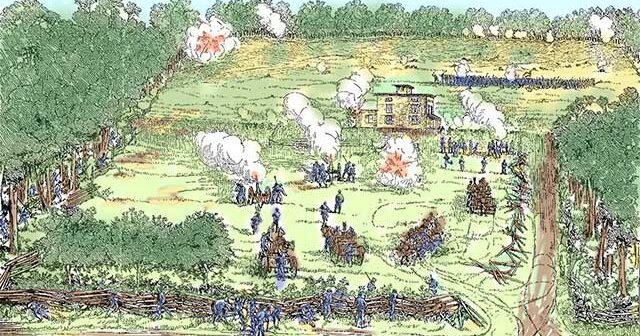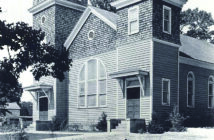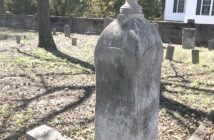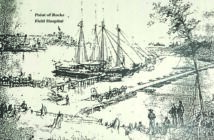Historian George “Buddy” Cranford wrote in the Village News last year about a Civil War battle in the Bermuda Hundred campaign that took place on May 10, 153 years ago on land surrounding a little yellow house simply known then as the Winfree House.
Cranford wrote that the sound and blasts from the cannon were breaking the glass panes in the windows and bullets were flying about. “The woman who lives there approaches Colonel William Fowler of the Union troops with a fierce glare in her eyes, walked to the lane fence and, in a tone of voice indicating she was both angry and excited, ordered him to take the guns away; and tells him to leave. “ The colonel suggested she go to her cellar for safety but was persistent about her plead for them to leave and refused to go.The battle became known as the Battle of Chester Station, and the little yellow house still stands, much as it was in 1864. The historic home is flanked by the Sunset Memorial Cemetery on one side and the Chester Y on the other.
Cranfordwrote that the action at Chester Station was a relatively minor battle of the Bermuda Hundred Campaign and itended indecisively. The battle started as a Union expedition against the Richmond & Petersburg Railroad. The object was to destroy the railroad in order to cut the line of communication.
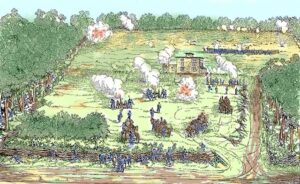
A DRAWING OF THE SKIRMISH SURROUNDING THE YELLOW HOUSE. NO LONGER YELLOW THE HOUSE STILL STANDS EAST OF THE YMCA SET BACK FROM WEST HUNDRED ROAD.
Cranford’s research found that the intent was to dislodge the Union sharpshooters. Confederates tried twice to break the Union line. The 9th and 38th Virginia Infantry charged down the turnpike (Jefferson Davis Highway), and part of the 169th New York Infantry gave way, abandoning that portion of the line and one cannon. The 14th, 53rd, and 57th Virginia infantries converged from three directions to make the second assault on the Federals around the Winfree House. As the defenders’ ammunition dwindled, desperately needed Union infantry and artillery reinforcements arrived just in time, deploring directly into the Winfree House lane and along the turnpike and checking the Virginians’ advance. Outnumbered, the beleaguered Southerners began to give ground. Adding to the confusion, Federal artillery shells ignited the woods early in the action, and the smoke and flames driving into the Confederate lines blinded them and deranged the precision of movements. Both sides fought gallantly and fiercely, including hand-to-hand combat. The Federals soon retired to their Bermuda Hundred lines.
The Union forces succeeded in destroying some railroad track, and the Confederate forces succeeded in stopping them from doing any more damage. In the drawing, the 1st Connecticut Light Battery is posted near the Winfree House to repulse Confederate forces.
General Alfred H. Terry, 1st Division, X Corps, reported loss of 280 killed, wounded, and missing. Some 50 prisoners remained in the hands of the Federals.
The casualties in General Seth M. Barton’s brigade showed a total of 249 killed, wounded, and missing, including the loss of a commanding officer of
one of his regiments, Lt. Col. Joseph R. Cabell of the 385th Virginia Infantry.

